1. 基本信息
| 题目 | 论文作者与单位 | 来源 | 年份 |
|---|---|---|---|
| Span-based Joint Entity and Relation Extraction with Transformer Pre-training | Markus Eberts ,Adrian Ulges,莱茵曼应用技术大学 | ECAI | 2019 |
76 Citations, 50 References
论文链接:https://arxiv.org/abs/1909.07755
论文代码:https://github.com/markus-eberts/spert
2. 要点
| 研究主题 | 问题背景 | 核心方法流程 | 亮点 | 数据集 | 结论 | 论文类型 | 关键字 |
|---|---|---|---|---|---|---|---|
| 信息抽取 【基于span的联合模型】 |
Based on BIO/BILOU labels, it can not identify overlapping entities, while span-based approch can do ; | 0. 任意地生成一批span候选; 1. 对每个span进行实体类型分类(classify each span into entity types); 2. 过滤掉非常实体;fifilter non-entities, 3. 对剩下的实体进行关系分类(classify all pairs of remaining entities into relations ) |
1. 区别于pipeline的方法–the approach detects entities among all token subsequences (or spans). 2. Span Filtering, 过滤不是实体的span. 3. each sentence only once through BERT (single-pass); |
CoNLL04,SciERC, ADE | 1. up to 2.6% F1 score; 2. demonstrate the benefifits of pre-training;strong negative sampling and localized context; |
BERT,SpERT, single-pass,strong negative sampling,localized context |
可能存在不足: 这个候选spans是怎么来的?如果spans的候选太多,是否在效率方法有影响?
3. 模型
提出SpERT,“Span-based Entity and Relation Transformer”
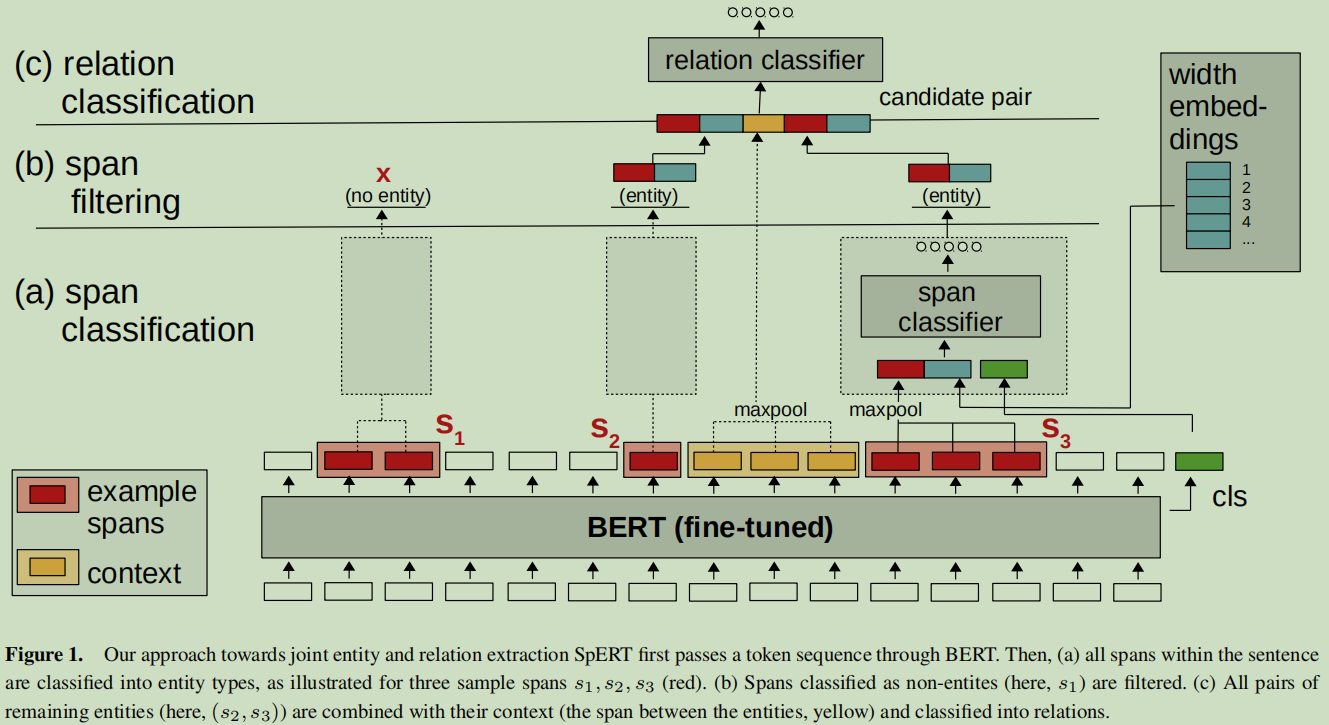
(a)Span Classifification(Span 分类)
-
Our span classififier takes an arbitrary candidate span as input.
-
句子 --[tokener]–> BPE tokens --[bert]–>“ (e_1, e_2, …e_n, c)”, 这里的c为一个分类token, 通过整个句子的上下文计算得来的。
-
s := (e_i, e_i+1, …,e_i+k)表示,长度为k个子词s;
-
实体类型:E∪{ none}, 基中E表示有意义预先定义好的实体类型;
-
图的虚线box表示span classification.
-
输入分成三部分:span’s BERT embeddings (red) + span级的索引嵌入(blue) + 分类符c(green)



三条公式的意思为:把输入的三部分连接成一个长的张量,输入到全连接神经网络进行softmax分类。
(b) Span Filtering
过滤掉 none 类。先过滤大于10token的span.
© Relation Classifification
- R是预定义好的关系;
- 对每个候选对(s1*, s*2)进行分类;
- 输入:BERT/width embeddings e(s1), e(s2) + localized context(两个实体围起来的那部分上下文,采用max-pooling合并的,yellow) --换c给换了,因为c代表了一句话,localied context更具有这两实体表达特征能力,记为c(s1*, s2); 特别地,如查s1与s2重合了c(s1, s*2) = 0


3.1 训练
- 要学习的参数:s (Ws, bs , Wr, br ) 及 bert的fine-tune;
- 损失函数:L = span的分类损失 (cross-entropy over the entity classes including none) + binary crossentropy over relation classes
- span分类,采用正负样本的方法来进行;对于关系分类也是正负样本的方法来进行(负样本就是在一个句子中的主语与宾语相交换);这里样本的构成都是在一个句子中的,没有跨多句;
- 每个句子只用了一次bert进行编码;
4. 实验与分析
-
数据集:CoNLL04,SciERC, ADE
-
一般bert模型:BERT_BASE (cased); 对于SciERC:SciBERT (cased)
-
训练过程中,bert的参数也是要调参学习的
-
Comparison with state of the art
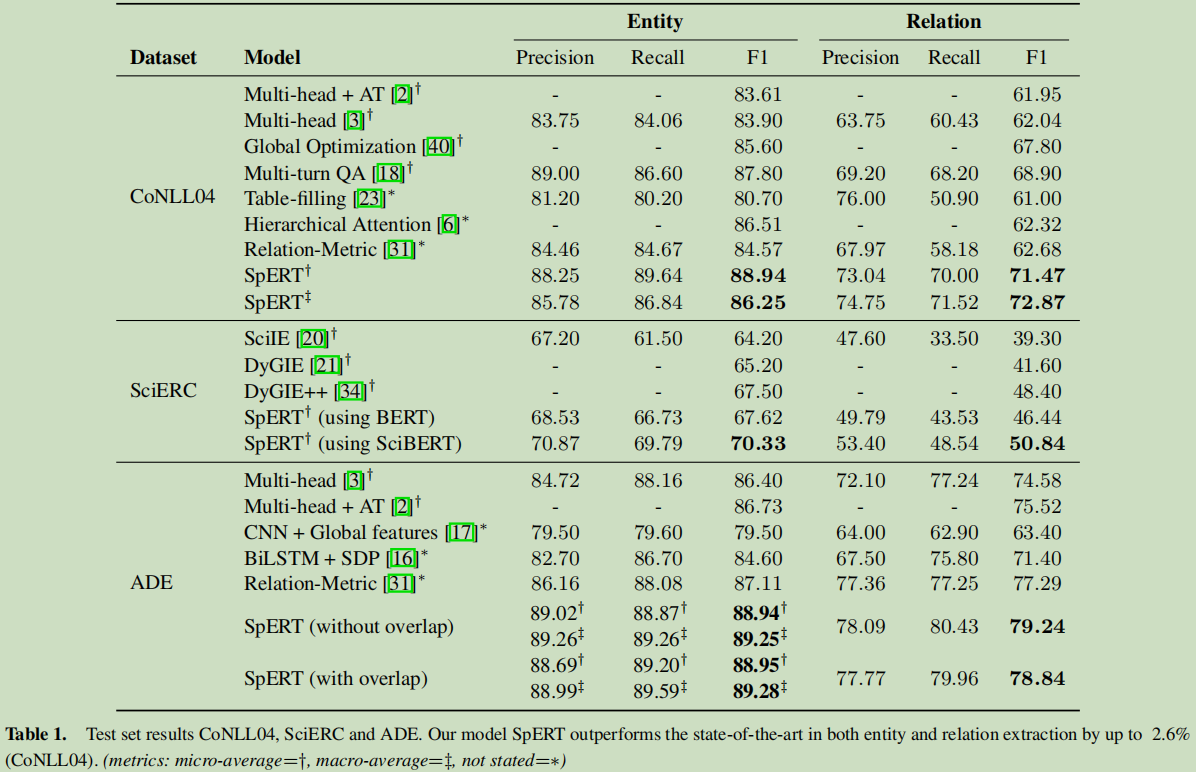
-
Candidate selection and negative sampling
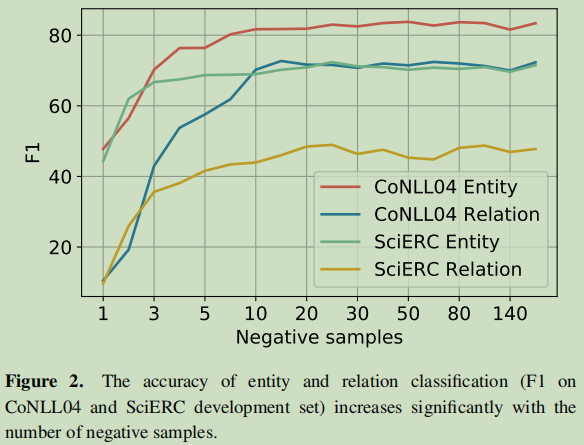
-
Localized context(两个实体中间的文本)
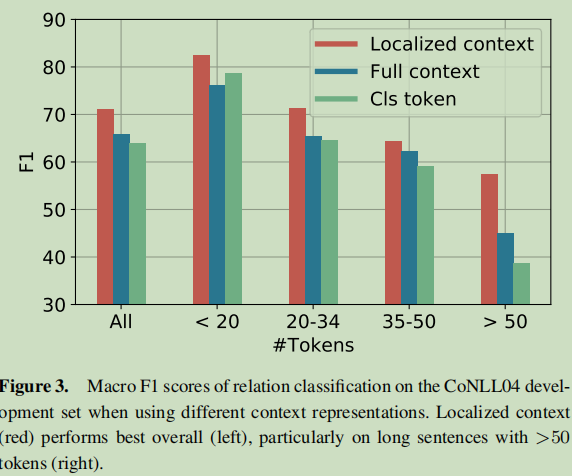

-
Pre-training and entity representation
研究bert预训练模型的影响。
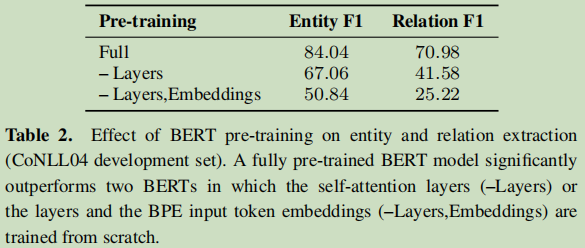
-
Error inspection
案例分析

-
-
-
5. 总结(不足,适用条件,写作框架)
-
more elaborate forms of context for relation classififiers;
-
Employing additional syntactic features or learned context;
问题:这个候选spans是怎么来的?如果spans的候选太多,是否在效率方法有影响?论文中只是来了一句""
6. 知识整理(知识点,文献分类)
Joint Entity and Relation Extraction:
Miwa and Sasaki [23]把联合实体与关系抽取问题看成是一个填表问题;每个单元格对应于两实体对; Gupta et al. [10],也是填表,与前一个不同的时,他合知birnn;
Miwa and Bansal [22], BILOU scheme; Zhou et al. [42] utilize a BILOU-based LSTM与CNN的组合;
。。。。
与本文比较相似的:[18] Xiaoya Li, Fan Yin, Zijun Sun, Xiayu Li, Arianna Yuan, Duo Chai, Mingxin Zhou, and Jiwei Li, ‘Entity-Relation Extraction as Multi-TurnQuestion Answering’, in Proc. of ACL 2019, pp. 1340–1350, Florence,Italy, (July 2019). ACL.
这个论文好像也用到了提示的模板。
Span-based Approaches
基于 BIO/BILOU解决不了overlapping的问题。
7. 参考文献
【1】 Kenton Lee, Luheng He, Mike Lewis, and Luke Zettlemoyer, ‘Endto-end Neural Coreference Resolution’, in Proc. of EMNLP 2017, pp. 188–197, Copenhagen, Denmark, (September 2017). ACL.